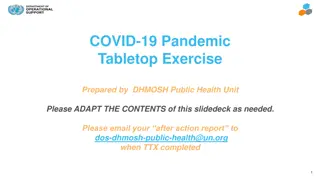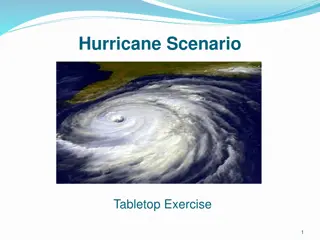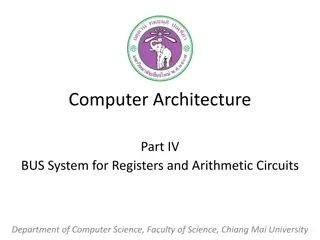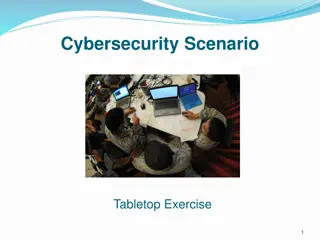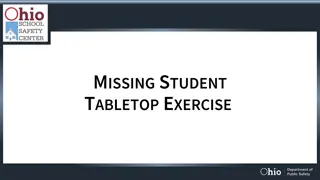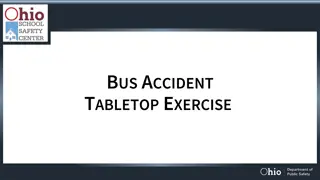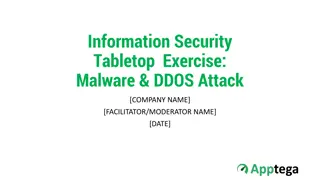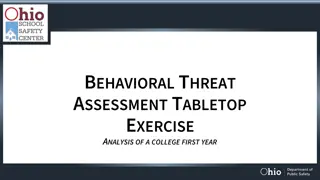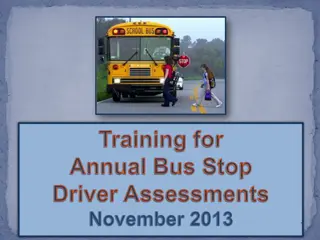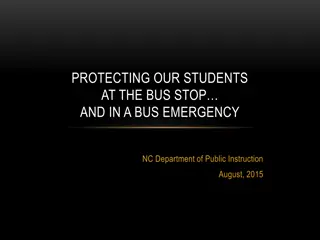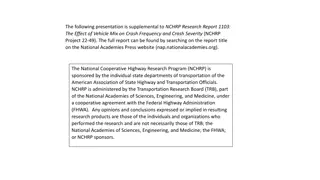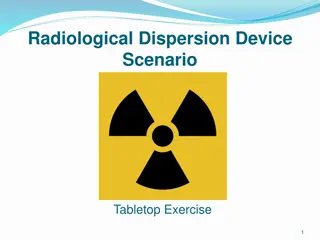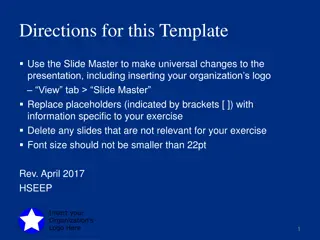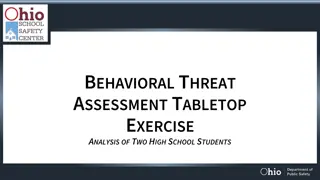Team Bus Crash Tabletop Exercise Agenda
Welcome and introductions set the stage for an exercise aimed at testing preparedness and response capabilities in a school-adjacent vehicular crash scenario. The exercise goals focus on coordination, relationship-building, improvement identification, and corrective action planning. Objectives include assessing roles, testing procedures, local coordination, and transportation abilities. Participants play various roles, and the exercise is structured into modules with facilitated discussions. Rules emphasize open dialogue and exploring various viewpoints.
Download Presentation

Please find below an Image/Link to download the presentation.
The content on the website is provided AS IS for your information and personal use only. It may not be sold, licensed, or shared on other websites without obtaining consent from the author.If you encounter any issues during the download, it is possible that the publisher has removed the file from their server.
You are allowed to download the files provided on this website for personal or commercial use, subject to the condition that they are used lawfully. All files are the property of their respective owners.
The content on the website is provided AS IS for your information and personal use only. It may not be sold, licensed, or shared on other websites without obtaining consent from the author.
E N D
Presentation Transcript
Team Bus Crash Tabletop Exercise
Exercise Agenda Welcome and Introductions Housekeeping Exercise Overview Goals Rules Objectives/Core Capabilities Assumptions and Artificialities Roles and Responsibilities Schedule Structure Scenario-Driven Exercise Facilitated Discussion in Four Modules Hot Wash Closing Comments Debrief
Welcome and Introductions Opening Remarks Facilitator Introductions Hosting Agency Participants Exercise Staff
Exercise Goals Test plans to prepare for, respond to, and recover from an vehicular crash situation near our school. Ensure effective coordination of plans and actions with school and community partners. Strengthen relationships with our response partners. Identify areas for improvement and develop a corrective action plan.
Objectives and Core Capabilities Assess the roles and responsibilities of the school administration and staff in testing evacuation, emergency response and recovery efforts. Assess the ability to effectively test the notification and activation procedures of the School community Determine strengths and weaknesses in local coordination and integration of response resources. Identify critical issues and potential solutions Test the abilities of utilizing Critical Transportation
Participants Roles and Responsibilities Players: Respond to the situation presented, based on expert knowledge of response procedures, current plans and procedures, and insights derived from training. Facilitator(s): Responsible for moderating and keeping participant discussions focused on exercise objectives and core capabilities, and ensuring relevant issues are explored; provide situational updates and additional information; resolve questions as required.
Exercise Structure A scenario-driven, facilitated discussion-based exercise The exercise is divided in four modules: oModule 1: Initial Response Scenario Background oModule 2: Response Scenario Update #1 oModule 3: Response Scenario Update #2 oModule 4: Recovery Scenario Update #3 Debrief
Rules for Players There are no right or wrong answers/ideas. Varying viewpoints are expected and will be respected. Exercise decisions are not precedent setting. Players are encouraged to consider different approaches and suggest improvements/ Think outside the box.
Ground Rules This is not a test of current capabilities and plans. It is a discussion of probable responses to a hypothetical emergency. The exercise will be an open dialogue. All ideas and input are welcome. One person speaks at a time. The scenario will be accepted as is. However, the facilitator may make modifications as deemed appropriate. No hypothetical resources are available.
Assumptions and Artificialities The exercise is conducted in a no-fault learning environment wherein capabilities, plans, systems and processes will be evaluated. Participants respond to the TTX scenario events and other exercise information from the perspective of their school s current policies, plans, processes and capabilities. The exercise scenario is plausible, and events occur as they are presented in the TTX scenario, allowing for artificialities. All players receive information at the same time.
Exercise Schedule Exercise Logistics and Set-up Registration Welcome and Introductions Exercise Overview Module 1: Initial Response Scenario Background Module 2: Response Module 3: Recovery Break Hot Wash Closing Comments Debrief
Tabletop Processes A scenario and update statements will be used to generate discussion of probable response actions. Participants will provide situational responses based on established procedures and plans. The Emergency Operations Plan (should be) available for reference. Other than maps and diagrams, no additional materials will be provided. The exercise will conclude with development of action steps needed to support future mitigation and preparedness efforts.
Exercise Guidelines Respond based on your knowledge of your school plans and capabilities. Discuss and present multiple options and possible solutions. Be aware that each phase will not have complete resolution. Any issues that cannot be resolved within a reasonable period of time will be tabled as an after-action item. If more information is needed, ask. Assume any agencies that are requested are initiating their response plans.
Module 1 Initial Response: Scenario Background
Scenario It s a Friday afternoon and the boy s soccer team is headed to a big game against their rival. The weather is clear but overcast. There are 22 students, and two coaches on the team bus traveling to the game, along with the bus driver. The driver suddenly loses control of the bus while taking a sharp turn and the bus overturns on a remote stretch of Interstate 89, about 40 miles from the school. You are alerted to the crash by a call from the coach who has also dialed 911 to report the incident.
Discussion Based on the information that you have, what specific immediate actions do you take? Explain your reasoning? What immediate information do you need and how will you get it? Based on your current EOP, what is your response protocol in a situation like this? What notifications must be made? Who will be notified? How will they be notified? Who will make the notifications?
Discussion Will someone travel to the scene? If so, who will that be? What will their responsibility be once they arrive?
Module 2: Response
Scenario You learn that 20 people are injured, however it is unknown at this point how extensive the injuries are. There is also one student fatality. Four people are uninjured. Several area rescue and fire departments respond to the scene and mutual aid is requested due to the number of injured and the severity of the crash. The Vermont State Police are the responding law enforcement agency. The injured are transported to two area hospitals dependent on the severity of their injuries. Students have begun to make calls, send text messages and live feeds from the scene.
Discussion Based on the information that you have, what specific response actions will you take and why? What are your immediate concerns regarding the students? What are your immediate concerns regarding communication with parents? How will you handle the media inquiries that are beginning to inundate the school? How does your EOP address communication with the broader school community who are learning about this incident through social media? Who is in charge and where will that person be? At the school? At the crash scene? At the hospital?
Module 3: Response - Scenario Update
Scenario Update School officials report to both hospitals. The names of the injured and deceased have not yet been officially released however, due to social media a great deal of information has been generated, some of which is inaccurate. Additionally, news of the bus crash has been reported by the media and several Vermont news station are requesting an interview with a school representative. State police are having difficulty reaching the deceased s parents who are currently traveling out of the State but have likely already been alerted to this incident via social media.
Discussion How will you work with the police in notifying the parents of the deceased? How will you communicate accurate information to the parents/ family of the other students and staff who were on the bus? What initial action, if any, will you take in speaking with the bus driver? How will you coordinate and work with law enforcement during the investigation and in the days following the incident?
Module 4: Recovery
Scenario The families of the deceased and injured have been notified, but some were previously made aware of the incident through social media. Blood work from the bus driver showed high levels of marijuana in his system at the time of the crash. The driver is an employee of the school district.
Discussion How will your crisis team deal with this event? If you do not have a crisis team, what other resources do you have available? Are there local mental health agencies whose services you can use and what is your relationship with those agencies? What steps will you take in working with law enforcement? What steps will you take related to the bus driver s impairment?
Discussion What is the procedure for notifying the community about an event like this? Who from the school is the representative that speaks with the media? What information will you release and why or why not? What are the procedures for this?
Discussion Will there be a day of memoriam? What mental health services will be provided to you school community following this incident? Who will make the decision about the continuation of classes following this incident? What kinds of messaging are we providing families and the media? Will you coordinate any media releases or press conferences with law enforcement? Based on this scenario, what changes will you make in your EOP?
Hotwash Did this exercise increase your awareness of needs related to a school event that occurs away from the school campus? What changes will you make, if any, to your EOP in order to properly prepare for and handle an incident similar to this? Are there resources that you have not previously identified, that you feel you would need in order to effectively handle this kind of situation? If so, what next steps will you take to become more prepared?
Where do we go from here? Specific Issues Identified Person assigned to follow-up Timeline of completion 3, 6, 9 months
Contact the Vermont School Safety Center Web Site Vermont School Safety Center Web Site Twitter https://twitter.com/vted_safeschool
Stay Connected With Us @margolishealy www.facebook.com/margolishealy www.linkedin.com/company/margolis-healy-&-associates









